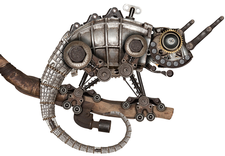Control USB-powered devices with a Raspberry Pi
Power Point

© Lead Image © Burmakin Andrey, 123RF.com
Command-line tools and Node-RED on a Raspberry Pi let you control projects that use the USB ports.
For home automation projects, a Raspberry Pi offers a simple, low-cost approach to managing and controlling a wide variety of devices. Typically these devices are either digitally wired 0-5V devices such as motion detectors, or wireless Ethernet devices such as smart plugs. It's important to note that a Raspberry Pi can also control USB-powered devices, such as USB fans, lights, and low-end controllers.
In this article, I look at how to monitor, control, and measure USB power in two Raspberry Pi projects. The first project uses Node-RED to create a web dashboard to monitor and control USB lights. The second project turns on USB cooling fans according to the Pi's CPU temperature.
Controlling USB Ports
A number of techniques allow you to control USB ports, and I found that one of easiest approaches is to use the uhubctl [1] utility, which lets you view and control local USB ports and ports on smart USB hubs. To load this utility, enter:
[...]
Buy this article as PDF
(incl. VAT)
Buy Linux Magazine
Subscribe to our Linux Newsletters
Find Linux and Open Source Jobs
Subscribe to our ADMIN Newsletters
Support Our Work
Linux Magazine content is made possible with support from readers like you. Please consider contributing when you’ve found an article to be beneficial.

News
-
Parrot OS Switches to KDE Plasma Desktop
Yet another distro is making the move to the KDE Plasma desktop.
-
TUXEDO Announces Gemini 17
TUXEDO Computers has released the fourth generation of its Gemini laptop with plenty of updates.
-
Two New Distros Adopt Enlightenment
MX Moksha and AV Linux 25 join ranks with Bodhi Linux and embrace the Enlightenment desktop.
-
Solus Linux 4.8 Removes Python 2
Solus Linux 4.8 has been released with the latest Linux kernel, updated desktops, and a key removal.
-
Zorin OS 18 Hits over a Million Downloads
If you doubt Linux isn't gaining popularity, you only have to look at Zorin OS's download numbers.
-
TUXEDO Computers Scraps Snapdragon X1E-Based Laptop
Due to issues with a Snapdragon CPU, TUXEDO Computers has cancelled its plans to release a laptop based on this elite hardware.
-
Debian Unleashes Debian Libre Live
Debian Libre Live keeps your machine free of proprietary software.
-
Valve Announces Pending Release of Steam Machine
Shout it to the heavens: Steam Machine, powered by Linux, is set to arrive in 2026.
-
Happy Birthday, ADMIN Magazine!
ADMIN is celebrating its 15th anniversary with issue #90.
-
Another Linux Malware Discovered
Russian hackers use Hyper-V to hide malware within Linux virtual machines.

